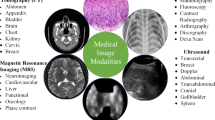Abstract
Breast tumors are the major malignancy in females and diagnostic systems using artificial intelligence algorithms for breast imaging have shown promising results. Among many algorithms, a deep convolutional neural network (DCNN) using K-means clustering and a multiclass support vector machine model enhance the precision of categorizing breast tumors from mammogram images. Nonetheless, effective breast tumor identification is still difficult without partitioning the pectoral muscle (PM) boundary from the remaining breast area. Therefore, this article proposes an Ensemble-Net model by ensembling the transfer learning model with different pre-trained CNN structures for partitioning the PM boundary from the remaining breast area in the mammographic scans. The segmentation process has 2 phases. In the initial phase, different region-of-interests are generated that include the object according to the input images. In the secondary phase, the object class is predicted after the areas of bounding boxes are refined and a pixel-range mask is created for the entity. These 2 different phases are associated with the backbone structure which creates the pyramid hierarchy of DCNN to acquire the features from the raw images. Moreover, it employs global average pooling followed by the softmax classification to recognize the normal, benign and malignant cases. Finally, the experimental outcomes demonstrate that the Ensemble-Net achieves 96.72% accuracy than the other classical classifiers.






Similar content being viewed by others
Availability of data and materials
Data sharing is not applicable to this article as no new data were created or analyzed in this study.
References
Akram M, Iqbal M, Daniyal M, Khan AU (2017) Awareness and current knowledge of breast cancer. Biol Res 50(1):1–23
Ginsburg O, Yip CH, Brooks A, Cabanes A, Caleffi M, Dunstan Yataco JA, Gyawali B, McCormack V, McLaughlin de Anderson M, Mehrotra R, Mohar A (2020) Breast cancer early detection: a phased approach to implementation. Cancer 126:2379–2393
Mendes J, Matela N (2021) Breast cancer risk assessment: a review on mammography-based approaches. J Imaging 7(6):1–20
Meenalochini G, Ramkumar S (2021) Survey of machine learning algorithms for breast cancer detection using mammogram images. Mater Today Proc 37:2738–2743
Michael E, Ma H, Li H, Kulwa F, Li J (2021) Breast cancer segmentation methods: current status and future potentials. BioMed Res Int 2021:1–29
Pang T, Wong JHD, Ng WL, Chan CS (2020) Deep learning radiomics in breast cancer with different modalities: overview and future. Expert Syst Appl 158:1–15
Kaur P, Singh G, Kaur P (2019) Intellectual detection and validation of automated mammogram breast cancer images by multi-class SVM using deep learning classification. Inform Med Unlocked 16:1–15
He K, Gkioxari G, Dollár P, Girshick R (2017) Mask RCNN. In: Proceedings of the IEEE international conference on computer vision, pp 2961–2969
Al-Masni MA, Al-Antari MA, Park JM, Gi G, Kim TY, Rivera P, Valarezo E, Choi MT, Han SM, Kim TS (2018) Simultaneous detection and classification of breast masses in digital mammograms via a deep learning YOLO-based CAD system. Comput Methods Programs Biomed 157:85–94
Chougrad H, Zouaki H, Alheyane O (2018) Deep convolutional neural networks for breast cancer screening. Comput Methods Programs Biomed 157:19–30
Wu N, Phang J, Park J, Shen Y, Huang Z, Zorin M, Jastrzębski S, Févry T, Katsnelson J, Kim E, Wolfson S (2019) Deep neural networks improve radiologists’ performance in breast cancer screening. IEEE Trans Med Imaging 39(4):1184–1194
Mohanty F, Rup S, Dash B, Majhi B, Swamy MNS (2020) An improved scheme for digital mammogram classification using weighted chaotic salp swarm algorithm-based kernel extreme learning machine. Appl Soft Comput 91:1–16
Yu J, Tan M, Zhang H, Rui Y, Tao D (2022) Hierarchical deep click feature prediction for fine-grained image recognition. IEEE Trans Pattern Anal Mach Intell 44(2):563–578. https://doi.org/10.1109/TPAMI.2019.2932058
Agarwal R, Díaz O, Yap MH, Llado X, Marti R (2020) Deep learning for mass detection in full field digital mammograms. Comput Biol Med 121:1–10
Dabass J, Hanmandlu M, Vig R (2020) Classification of digital mammograms using information set features and Hanman Transform based classifiers. Inform Med Unlocked 20:1–8
Sapate S, Talbar S, Mahajan A, Sable N, Desai S, Thakur M (2020) Breast cancer diagnosis using abnormalities on ipsilateral views of digital mammograms. Biocybern Biomed Eng 40(1):290–305
Xie L, Zhang L, Hu T, Huang H, Yi Z (2020) Neural networks model based on an automated multi-scale method for mammogram classification. Knowl Based Syst 208:1–9
Shu X, Zhang L, Wang Z, Lv Q, Yi Z (2020) Deep neural networks with region-based pooling structures for mammographic image classification. IEEE Trans Med Imaging 39(6):2246–2255
Salama WM, Aly MH (2021) Deep learning in mammography images segmentation and classification: automated CNN approach. Alex Eng J 60(5):4701–4709
Yu J, Yao J, Zhang J, Yu Z, Tao D (2020) SPRNet: single-pixel reconstruction for one-stage instance segmentation. IEEE Trans Cybern 51:1731–1742
Funding
Not applicable.
Author information
Authors and Affiliations
Corresponding author
Ethics declarations
Conflict of interest
The authors declare that they have no conflict of interest.
Informed consent
Informed consent does not apply as this was a retrospective review with no identifying patient information.
Human and animal rights
This article does not contain any studies with human or animal subjects performed by any of the authors.
Additional information
Publisher's Note
Springer Nature remains neutral with regard to jurisdictional claims in published maps and institutional affiliations.
Rights and permissions
About this article
Cite this article
Nagalakshmi, T. Breast Cancer Semantic Segmentation for Accurate Breast Cancer Detection with an Ensemble Deep Neural Network. Neural Process Lett 54, 5185–5198 (2022). https://doi.org/10.1007/s11063-022-10856-z
Accepted:
Published:
Issue Date:
DOI: https://doi.org/10.1007/s11063-022-10856-z




